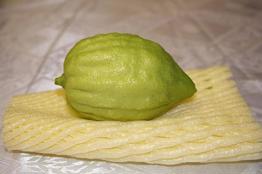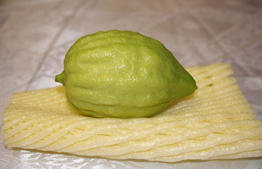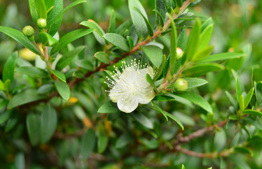Pesticide Traces in Etrogim

Etrogim must be edible to be fit for use in the arba minim. Every year, the issue of pesticide traces arises, putting into question if it is, in fact, edible and if it is dangerous to eat etrog jam.
Background
Protecting the etrog so it will be mehudar, clear of blotches and defects, is no simple feat. To achieve this, many steps are taken in the orchard. Some are mechanical, to protect the fruit from touching branches or thorns; others involve spraying pesticides to protect against pests and maladies. Since the fruit is not mainly intended to be eaten, there is hardly any licensing for etrog pesticides or regulation for the pesticide traces existent in the fruit.
However, for the etrog to be kosher for the mitzvah of arba minim, if must be edible.[1] For this reason, it cannot be orlah or tevel. The question is asked, therefore, if the pesticide traces harm etrogim to the point where it is considered inedible, which would then disqualify them halachically.
Furthermore, this situation raises a health consideration: since the etrogim are doused in pesticides, are they healthy to eat or do they present a health hazard (even if they are deemed halachically fit for a blessing)?
Halachic discussion about sprayed etrogim
We have found in halachic literature several disqualifiers tied to their being edible. Besides the need for the etrog to not be orlah or tevel,[2] it is brought in the Shulchan Aruch[3]that an etrog that spoiled is disqualified for the arba minim. The Magen Avraham discusses a case when an etrog contains a forbidden mixture deeming it forbidden to eat; while he forbids using the etrog on the first day of Sukkot, he permits it for the subsequent six days of the holiday.[4] Others permit using such an etrog even on the first day, if no other is available.[5] Halichot Shlomo[6] states that one fulfills his obligation using an etrog sprayed with pesticides, but explained that this is because the pesticides disintegrate 30 days after application, so after this time the etrog is considered edible. In contrast, Hameracheshet[7] discusses the issue and concludes that it depends on a dispute between Rashi and Rabbeinu Tam.[8] Kashrut Arba'at Haminim[9] discusses the matter and cites rationale to permit and forbid sprayed etrogim.
Assessing the situation with regard to pesticides
Pesticides can be classified into different groups depending on their biological mechanism function. A basic distinction can be drawn between substances that penetrate the plant and are transported throughout its phloem and xylem (systemic) and those that barely penetrate the plant and only remain on its outer layer. The penetrative ability and movement within plants also vary within the group of systemic substances. Moreover, we need to distinguish between substances that disintegrate relatively quickly and residual substances that can be found within the plant for long periods of time, even for more than one year. It is very important to note that while residual characteristics are linked to the substances, they are also linked to the plant. While there are some substances that are not generally residual, for certain plants they will be residual, and vice-versa.
Confidor,[10] cited by responsa of the posekim on the topic, is a substance that is absorbed by the plant either through its roots or its leaf pores. This chemical, belonging to the group of neonicotinoids, can accumulate in a fruit and remain until after harvest. In some of the responsa, the reason for the heter to use etrogim sprayed with pesticides is that the substance disintegrates after thirty days. It seems that the intent of these posekim is that citrus growers would spray thirty days prior to harvest, since after this time the spray is expected to disintegrate and reach permitted levels by harvest time.[11] Based on this, some posekim say, as we saw above, that even if traces are still detectable in the etrog after harvest, after thirty days it will be fit for use. However, note that in most cases the disintegration of chemical substances in plants before harvest takes place in a shorter period of time in comparison to disintegration following harvest. For this reason, it stands to reason that the presence of high levels of pesticide traces in the fruit after harvest, the disintegration process will take more than thirty days, while for certain substances and under certain conditions, the process will all but stop. There are many reasons that pesticides disintegrate rapidly while the fruit is still attached to the tree: as long as the fruit continues to grow on the tree, the percentage of pesticides in the fruit remains low, the fruit is exposed to solar radiation and varying temperatures, the metabolic activities in both the plant and fruit continues, among others. There is an even further significant delay in the disintegration process when stored in low or moderate temperatures. For this reason, to employ a heter to use an etrog sprayed with pesticide for the arba minim based on the definite disintegration of these substances is not clear-cut, since it depends on the type of pesticide and storage conditions. Moreover, besides Confidor, there may be other pesticides used on the etrog, each with differing behavior, some of which can remain in the fruit a long time.
Other possible reasons for the heter
However, even without addressing the disintegration of all of the pesticides, we can find other reasons to permit using etrogim sprayed with pesticides as part of the arba minim.
1. The disintegration of substances in cooking or other processes
There are currently many studies being carried out to assess the effects of various processes during food preparation on the disintegration of pesticides. Most studies indicate that acts like washing, grinding, filtering, and cooking cause pesticide traces to disintegrate at varying levels. For instance, various studies found that after baking bread there is a 50-70% drop in the levels of pesticide traces in relation to the amounts found in the dough before baking. A different study found that baking in a standard oven or microwave oven caused a drop of approximately 99% of the pesticide traces in relation to the amount before baking. For this reason, based on the heter of Rabbi Shlomo Zalman Auerbach regarding the possibility of eating the etrog after waiting a period of time, we can relate to other processes that can help accelerate pesticide trace disintegration as a basis for the heter. Cooking the etrog, for instance, can be expected to significantly reduce the pesticide traces, should such be present. Note that in rare cases, food processing can have a negative effect on the concentration of pesticide traces, such as an increase in concentration after filtration.
2. Immediate or cumulative danger
Most of the damage from pesticide traces is ongoing and cumulative and is not similar to poison, for instance. The concentration of pesticide traces found in produce is generally in parts per million (ppm). That is, these are miniscule quantities that cause damage for the long-term, but not immediately. Therefore, just as eating foods with high-sugar content are not deemed inedible despite the fact that they cause long-term damage, so too it is difficult to define an etrog as not worthy of human consumption even if it contains substances that cause damage in the long-term. Moreover, most of these substances are toxic when large quantities are consumed, but cause no substantial damage when eating a small quantity—as is the case with an etrog. For this reason, comparing an etrog to something completely inedible is inaccurate.
3. Parts of the fruit that remain clean or with a small amount of pesticide traces
As indicated by the results brought below, the internal part of the etrog was much clearer of pesticide traces than its outer peel and the probability of finding high concentrations of pesticides inside of the fruit is relatively low. Many studies indicate that the majority of the problem is in the peel of the fruit or vegetable, and if peeled the pesticide traces are much lower. Just like other citruses, the internal part of the etrog is the part generally eaten, so even if the peel contains high levels of traces, it would not be accurate to say that the etrog itself is inedible. While there are also pesticides that can accumulate within the fruit, in most of the cases, the percentages were relatively low (even if exceeding permitted amounts).
While today, Baruch Hashem, there is much more awareness on the issue of pesticides, it is important to note that without the use of pesticides in today's agriculture it would be impossible to feed the world's population. In the past, crop maladies or pests would wreak severe damage and in certain cases could even lead to famine.[12] Farmers are constantly balancing the need to supply consumers' demands for quality produce (a clean etrog, blemish-free vegetables, etc.) and the need for carefully monitored use of pesticides. Baruch Hashem, the industry is constantly working on developing soft pesticides and increasing their effectiveness in order to significantly reduce the amount of pesticide traces in food. Reducing pesticides presents a formidable challenge not only to farmers but to us as consumers. The more the demand for aesthetics is lowered, it will be possible to reduce the amounts of pesticides, many of which are applied to ensure beautiful, aesthetic products.
Tests on etrogim sprayed with pesticides
Torah VeHa'aretz Institute recently performed testing for pesticide traces in etrogim.[13] Prior to this, Prof. Eliezer Goldschmidt performed various tests on the topic. His findings were published approximately two years ago.[14] These tests were conducted in several orchards with small quantities of etrogim, so the results should be viewed with caution. In Dr. Goldschmidt's study, the etrogim were first scrubbed to remove pesticides, after which the concentration of pesticides in the etrog's external and internal portions were tested separately. In any event, the results indicate that the level of pesticide traces is not especially high, certainly not to the point that it would render the etrog to be inedible. The findings indicate that the traces in the peel are much higher than in the internal part of the fruit. Nonetheless, even in the fruit peel the amount of pesticide traces did not significantly exceed permitted amounts.
In the tests performed by Torah VeHa'aretz Institute, we tested dozens of Yemenite etrogim harvested randomly from orchards. Unlike in Dr. Goldschmidt's study, we did not perform any external cleaning before testing. In these tests no pesticides were found on the internal part of the etrog. On the outer peel, pesticide traces were detected but in relatively low concentrations.
Since the internal part of the etrog is the portion eaten, it seems that the findings of this study corroborate the conclusion that the assumption that etrogim are not fit for consumption is erroneous. Again, note that the scope of tests performed is insufficient to completely allay the concern of eating etrogim. Yet, we will quote from the article by Prof. Eliezer Goldschmidt and Assaf Evtebi:[15]
Externally cleaning the fruit removes a sizable amount of pesticides, but nevertheless the outer peel still contains significant amounts of pesticide traces. However, only in a few cases did these amounts exceed the permitted amounts, yet as we mentioned earlier it is impossible to directly compare the results with the Israeli standard. This said, in an absence of clinical tests it seems that it is not hazardous to consume a few etrogim for home use, as is customary in various groups, and there is no room to deem eating a few etrogim unsafe. In contrast, to prepare industrial products such as jam and cosmetics, it is best to prefer using etrogim that ripen on trees after Sukkot or from orchards that are not sprayed with dangerous amounts of pesticides.
Conclusion
The tests performed by Torah VeHa'aretz Institute corroborate the findings of Prof. Eliezer Goldschmidt and Assaf Evtebi, and their conclusions that there is no basis for disqualifying etrogim for use as part of the arbat haminim (besides the others reasons for the heter).
Addition by Rabbi Moshe Bloom
In light of the article above, it seems that eating etrog jam does not present a health hazard. The preparation of etrog jam from a few etrogim for family use, and where small amounts are eaten each time, is not dangerous. Consider, too, the conventional process of etrog jam preparation: the etrogim are soaked for a week and water is changed daily. Then the etrogim are peeled and boiled in water, during which the water is changed seven times. The findings above indicate that most pesticides do not penetrate beyond the etrog skin. Albeit, it would be best to send etrog jam samples for testing to completely substantiate the safety of etrog jam. However, even at this point, in contrast with the popular claim that etrog jam consumption is dangerous,[16] it seems that etrog jam consumption does not present a substantive health hazard.
[1] Sukkah 35a; see Tosafot, ibid.; Shulchan Aruch HaRav OC §549:15; this is also implied by Shulchan Aruch §549:5 (see also Mishnah Berurah on Shulchan Aruch, ibid.).
[2] Mishnah Berurah OC §549:45.
[3] Shulchan Aruch, OC §548:15.
[4] Magen Avraham OC §549: 20.
[5] Sha'ar Hatziyun §549:48, and writes that one should avoid saying the blessing.
[6] Halichot Shlomo, Tishrei-Adar 10:22; also brought by Yalkut Yosef, Kitzur Shulchan Aruch §548:53.
[7] Sefer Hameracheshet I §20; see also Ein Yitzchak OC §24.
[8] Dispute between Rashi and Rabbeinu Tam in Yevamot 71a.
[9] Kashrut Arba'at Haminim, p. 73.
[10] This is the commercial brand name; its active ingredient is imidacloprid.
[11] Note that this datum is for citrus in general, but it is not clear if it was checked specifically for etrogim.
[12] The Great Famine in Ireland (1846-1849), for instance, was the result of the potato blight (Phytophthora infestans).
[13] The tests were conducted at Bachtochem laboratories in Nes Tziyona.
[14] Prof. Eliezer Goldschmidt and Assaf Evtebi, "Examining pesticide traces in commercially grown etrog fruit," Hanoteya (2020) 74, pp.16-18 (Hebrew).
[15] Ibid.
[16] See for instance here: https://www.myjewishlearning.com/the-nosher/is-it-safe-to-eat-your-etrog/



